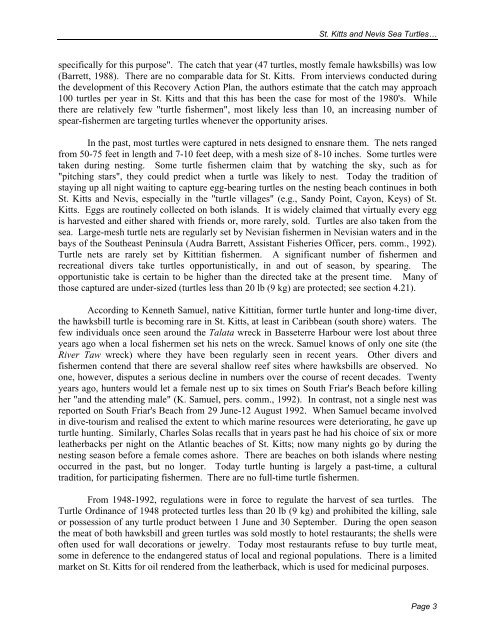Sea Turtle Recovery Action Plan for St. Kitts and Nevis - WIDECAST
Sea Turtle Recovery Action Plan for St. Kitts and Nevis - WIDECAST
Sea Turtle Recovery Action Plan for St. Kitts and Nevis - WIDECAST
You also want an ePaper? Increase the reach of your titles
YUMPU automatically turns print PDFs into web optimized ePapers that Google loves.
<strong>St</strong>. <strong>Kitts</strong> <strong>and</strong> <strong>Nevis</strong> <strong>Sea</strong> <strong>Turtle</strong>s…<br />
specifically <strong>for</strong> this purpose". The catch that year (47 turtles, mostly female hawksbills) was low<br />
(Barrett, 1988). There are no comparable data <strong>for</strong> <strong>St</strong>. <strong>Kitts</strong>. From interviews conducted during<br />
the development of this <strong>Recovery</strong> <strong>Action</strong> <strong>Plan</strong>, the authors estimate that the catch may approach<br />
100 turtles per year in <strong>St</strong>. <strong>Kitts</strong> <strong>and</strong> that this has been the case <strong>for</strong> most of the 1980's. While<br />
there are relatively few "turtle fishermen", most likely less than 10, an increasing number of<br />
spear-fishermen are targeting turtles whenever the opportunity arises.<br />
In the past, most turtles were captured in nets designed to ensnare them. The nets ranged<br />
from 50-75 feet in length <strong>and</strong> 7-10 feet deep, with a mesh size of 8-10 inches. Some turtles were<br />
taken during nesting. Some turtle fishermen claim that by watching the sky, such as <strong>for</strong><br />
"pitching stars", they could predict when a turtle was likely to nest. Today the tradition of<br />
staying up all night waiting to capture egg-bearing turtles on the nesting beach continues in both<br />
<strong>St</strong>. <strong>Kitts</strong> <strong>and</strong> <strong>Nevis</strong>, especially in the "turtle villages" (e.g., S<strong>and</strong>y Point, Cayon, Keys) of <strong>St</strong>.<br />
<strong>Kitts</strong>. Eggs are routinely collected on both isl<strong>and</strong>s. It is widely claimed that virtually every egg<br />
is harvested <strong>and</strong> either shared with friends or, more rarely, sold. <strong>Turtle</strong>s are also taken from the<br />
sea. Large-mesh turtle nets are regularly set by <strong>Nevis</strong>ian fishermen in <strong>Nevis</strong>ian waters <strong>and</strong> in the<br />
bays of the Southeast Peninsula (Audra Barrett, Assistant Fisheries Officer, pers. comm., 1992).<br />
<strong>Turtle</strong> nets are rarely set by Kittitian fishermen. A significant number of fishermen <strong>and</strong><br />
recreational divers take turtles opportunistically, in <strong>and</strong> out of season, by spearing. The<br />
opportunistic take is certain to be higher than the directed take at the present time. Many of<br />
those captured are under-sized (turtles less than 20 lb (9 kg) are protected; see section 4.21).<br />
According to Kenneth Samuel, native Kittitian, <strong>for</strong>mer turtle hunter <strong>and</strong> long-time diver,<br />
the hawksbill turtle is becoming rare in <strong>St</strong>. <strong>Kitts</strong>, at least in Caribbean (south shore) waters. The<br />
few individuals once seen around the Talata wreck in Basseterre Harbour were lost about three<br />
years ago when a local fishermen set his nets on the wreck. Samuel knows of only one site (the<br />
River Taw wreck) where they have been regularly seen in recent years. Other divers <strong>and</strong><br />
fishermen contend that there are several shallow reef sites where hawksbills are observed. No<br />
one, however, disputes a serious decline in numbers over the course of recent decades. Twenty<br />
years ago, hunters would let a female nest up to six times on South Friar's Beach be<strong>for</strong>e killing<br />
her "<strong>and</strong> the attending male" (K. Samuel, pers. comm., 1992). In contrast, not a single nest was<br />
reported on South Friar's Beach from 29 June-12 August 1992. When Samuel became involved<br />
in dive-tourism <strong>and</strong> realised the extent to which marine resources were deteriorating, he gave up<br />
turtle hunting. Similarly, Charles Solas recalls that in years past he had his choice of six or more<br />
leatherbacks per night on the Atlantic beaches of <strong>St</strong>. <strong>Kitts</strong>; now many nights go by during the<br />
nesting season be<strong>for</strong>e a female comes ashore. There are beaches on both isl<strong>and</strong>s where nesting<br />
occurred in the past, but no longer. Today turtle hunting is largely a past-time, a cultural<br />
tradition, <strong>for</strong> participating fishermen. There are no full-time turtle fishermen.<br />
From 1948-1992, regulations were in <strong>for</strong>ce to regulate the harvest of sea turtles. The<br />
<strong>Turtle</strong> Ordinance of 1948 protected turtles less than 20 lb (9 kg) <strong>and</strong> prohibited the killing, sale<br />
or possession of any turtle product between 1 June <strong>and</strong> 30 September. During the open season<br />
the meat of both hawksbill <strong>and</strong> green turtles was sold mostly to hotel restaurants; the shells were<br />
often used <strong>for</strong> wall decorations or jewelry. Today most restaurants refuse to buy turtle meat,<br />
some in deference to the endangered status of local <strong>and</strong> regional populations. There is a limited<br />
market on <strong>St</strong>. <strong>Kitts</strong> <strong>for</strong> oil rendered from the leatherback, which is used <strong>for</strong> medicinal purposes.<br />
Page 3
















